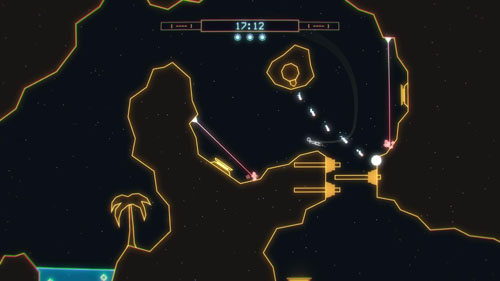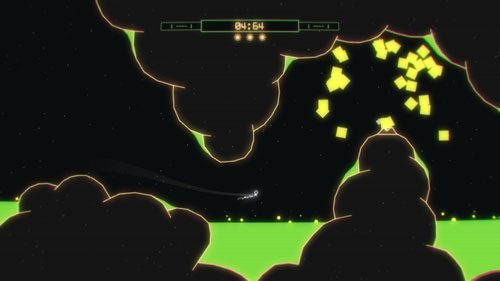A game by Chromosphere Games for PC and Mac, originally released in 2017.
Lunar Lander came to arcades in 1979, and Gravitar arrived in 1982, but in the decades that have passed since that time, there have been few entries in the gravity-based spaceship genre. In 1987, Thrust and Oids each offered their own takes on the formula, with Thrust focused on diving into planets and using precision flight to haul pods back to the surface using a rigid tow cable, while Oids had less of a focus on precision flight and resource management and instead centered around rescuing prisoners. Only a handful of developers have tried their hand at the formula in the modern era, with releases including Gravity Force, Gravity Clash, and the Gravitron series.The Royal Cosmonautical Society incorporates elements from many of its ancestors and offers a familiar but unique take on the genre. Like many genre antecedents, the game is presented with vector graphics (although the game has some pretty high-spec system requirements given that the graphics are barely more complex than those from 30 years prior) and features a spaceship that must use precision movement to navigate environments while experiencing the ever-present tug of gravity.
Unlike other genre entries, there is no resource management, as the player’s ship has infinite fuel. Instead, every level is a race against the clock.
There are 10 planets, each of which introduces new gameplay mechanics, with a dozen or so levels per planet, for a total of 140. However, new levels may only be opened by earning medals, and medals are earned based on level completion time.
The lowest-tier medal is practically guaranteed for competent completion of a level, since most mistakes are punished by death. The second-tier medal is within reach for skilled players on a first attempt, or possibly a second if they have a poor initial run. The top-tier medal, however, requires incredible precision, with the time requirements set against some of the developer’s best runs. To earn all three medals in a single level requires a near perfect run.
Fortunately, players can make steady progress by completing each level with one or two medals earned, and once the player clears 10-12 levels on a given planet, the next is unlocked. However, each planet (save the final) has a tough 14th level that can only be unlocked by averaging at least two medals per level. With new levels unlocked with reasonable skill, players can still make progress without perfection, but there are plenty of challenges remaining for players wishing to truly test their skills and earn all of the medals. Players’ level completion times may also be shared via online leaderboards.
Before exploring the planet-specific gameplay elements, it is important to note some of the design differences between The Royal Cosmonautical Society and its genre brethren. First, and most importantly, the player’s control over ship rotation is indirect. Rather than instantaneous rotation to the left and right - which is typical of the genre - the player instead engages thrusters that turn the ship clockwise and counterclockwise. As such, there is some inertia to rotational movement, making it less precise than other genre entries.
Additionally, ship rotation occurs more slowly than is traditional, and reversing rotational direction means fighting against momentum from the opposing thrust. This less forgiving control scheme means that it is more difficult to recover from mistakes or correct for over-turning, which makes navigating the environments more challenging.
Since the camera does not zoom in, it can also be difficult to determine the ship’s exact rotation while thrusting, making it somewhat more difficult to make the appropriate minor corrections. This lack of zoom can also make objectives difficult to determine, as it’s not always clear in which direction the player needs to travel. However, given that most levels can be completed in about 30 seconds, there is little penalty for being killed while feeling out the level.
Finally, unlike many other genre entries, hitting a solid surface does not necessarily spell death. As long as your ship’s feet are aimed toward the surface and you’re not going too fast, you can touch down or glance off a surface without exploding. This allows for some pretty brazen tactics when shooting for the best time in a given level, as players can rocket through levels and spin the ship around to absorb the force of impact… an action that is not typically rewarded in the genre. Some levels offer slippery ice and impenetrable shields that further emphasize these tactics.
The game begins on planet Earth, followed by the moon, and then onto a series of fictional planets. Disappointingly, the moon has the same gravity as Earth and all of the other planets, and aside from some attractors and repulsors late in the game, changing gravity is not explored as a gameplay element.
Things on Earth are fairly straightforward. The player needs to take off from a flat surface and set down on a landing pad, and sometimes the landing pad needs to be activated by grabbing a pickup in the environment. Here, the player learns to come to grips with the basic ship controls in a series of fairly easy levels (though still with tough time constraints).
From here, the player moves into levels that have exploding mines that act as insta-kill hazards. Smaller mines are stationary and appear in most levels, while larger mines slowly move toward the player when he gets close. While these moving mines are capable of killing on contact, they are doubly troublesome because they narrow your path of travel and force you to stay on the move, potentially causing you to make a mistake as you are pushed into smaller spaces.
There are several challenges built around different types of special abilities, which come in the form of a tow rope, a shield, and a grappling hook. Instead of having access to all of the abilities at once, certain levels are designed around the use of a specific ability.
The tow rope allows you to grab boxes and other objects and pull them around then environment, but these objects weigh the ship down, requiring heavy compensation to counteract gravity. And since these objects can swing back and forth and the tow rope is not rigid (as it was in Thrust), players must also compensate for the tug on their ship, and avoid smashing into them. Towed boxes can be used to activate switches that open doors, and they can be used to block laser blasts and incoming turret fire.
In many challenges, the player is required to get up to speed and disconnect the tow rope at the right moment to send objects flying in order to reach otherwise inaccessible switches. One challenge even sees the player pulling an orb out of a crevasse like pulling a stopper out of a bottle, flinging into the air, and then jetting down through the hole before the orb comes rolling back down to close the gap.
The shield makes the ship invincible for as long as it’s active, and since there is no fuel source, players may use it as often as they like. However, thrusting is deactivated when using the shield, as is ship rotation, which adds some complexity to the controls. As mentioned, it is possible to go skids-down and bang against solid walls without exploding, and the shield emphasizes this further by allowing the player to bash into walls at any speed. This sets up some pinball-like challenges where players must ricochet off walls and send their ship bouncing through laser fields.
The grappling hook is introduced toward the end of the game and allows players to quickly round corners by freely aiming the hook as they fly, grabbing walls, and then releasing the hook before slamming against the same walls. While many levels require fast flying in order to get the top-tier medals, grapple-focused levels allow for even faster action as the player boosts down shafts and blasts around corners at high speed.
In addition to these item-focused challenges, there are plenty of level elements that require strategies of their own. For instance, a water-based planet requires the player to dive beneath the surface and thrust downward in order to prevent the ship from floating back up, and the water has more resistance than open space, requiring more precise control.
Some levels feature gasses that prevent you from using your main thrusters (lest your ship explode), while others require you to keep your thrusters going full blast to keep your ship from freezing over. Some of these frozen levels also feature ice that you can slide across by boosting parallel to the ground and then landing on the ice to slide past obstacles and even around corners.
Every planet presents its own unique challenges, offering a tremendous amount of variety to a genre that traditionally offers little diversity from level to level beyond requiring more precision on the part of the player. Even within these themed planets, gameplay can vary from one level to the next, as players find themselves dodging turret fire, dashing for doors before they close, outrunning heat-seeking missiles, zipping under erupting plasma volcanoes, and dealing with emitters that attract or repulse the ship within a limited field.
2D CRED
The Royal Cosmonautical Society was developed by Chromosphere Games, a 1-person studio consisting of developer Nicole Graham.































0 comments:
Post a Comment